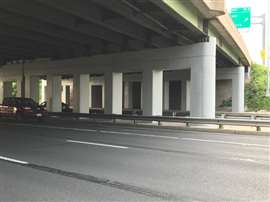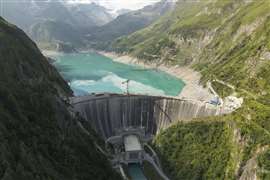Read this article in Français Deutsch Italiano Português Español
More than 42,000 US bridges ‘structurally deficient’ in 2024 - but number has fallen
06 September 2024
The number of US bridges in need of repair or replacement has reached nearly 221,800, according to analysis by the American Road & Transportation Builders Association (ARTBA).
 A 1950s bridge carrying northbound and southbound I-695 over US 40 in Catonsville, Baltimore County has come off the list of bridges in poor condition after construction work (Image: Maryland DOT)
A 1950s bridge carrying northbound and southbound I-695 over US 40 in Catonsville, Baltimore County has come off the list of bridges in poor condition after construction work (Image: Maryland DOT)
Of those needing repair, a total of 42,067 are classified as “structurally deficient” and rated in poor condition, although that is 324 fewer than was the case in 2023.
The proportion of US bridge inventory rated as being in poor condition has also fallen from 7.3% in 2020 to 6.8% in 2024.
ARTBA pointed to progress in several US states, with Pennsylvania recording the biggest decline in the number of bridges in poor condition (down 90), followed by Louisiana (down 87), Florida (down 85), West Virginia (down 74), and California (down 64).
States have received $15.9 billion in the first three years of the Infrastructure Investment and Jobs Act’s (IIJA) new $27.5 billion formula bridge program and to date have committed 46% ($7.3 billion) to over 4,170 bridge projects.
The remaining 54% ($8.5 billion) of bridge funds already released – plus another $10.6 billion that will be provided in the next two years – is expected to support bridge improvements into the future.
ARTBA found that 23 states have committed at least half of their available bridge formula funds, with the top 10 being: Georgia (100%), North Dakota (99%), Indiana (98%), Florida (96%), Oklahoma (95%), Nebraska (91.5%), Idaho (91.5%), Arkansas (88%), West Virginia (85%), and Alabama (85%).
Bridges that have come off the “poor condition” list include:
- I-695 over U.S. 40, Md.
- I-93 over Conley Street, Mass.
- I-680 over Capitol Avenue, Calif.
- I-55 over Madison Street, Ill.
- I-95 over Route 608, Va.
Bridges newly rated in poor condition include:
- I-90 over Canal to Stewart Streets, Ill.
- Interstate 680 over Monument Boulevard, Calif.
- I-93 over Mystic Valley Parkway, Mass.
- I-95 North and Southbound over Thurbers Avenue, R.I.
- IH-35 over Grand Avenue, Texas
Bridges are classified in good, fair, or poor condition based on their inspection ratings and definitions from U.S. DOT.
The definition of “poor” is when a key element of the bridge—the deck, superstructure, substructure, or culverts, are rated in poor or worse condition. During inspection, the conditions of a variety of bridge elements are rated on a scale of 0 (failed condition) to 9 (excellent condition). A rating of 4 is considered “poor” condition.
Dr Alison Premo Blac, ARTBA’s chief economist who conducted the analysis of federal government data, said, “Over the last five years we have seen significant progress in states like Oklahoma, Pennsylvania, Mississippi, Louisiana, and West Virginia – reducing the number of bridges in poor condition.
“While improvements can take time, every bridge repair increases the safety and efficiency of our network for the traveling public.”
STAY CONNECTED


Receive the information you need when you need it through our world-leading magazines, newsletters and daily briefings.
CONNECT WITH THE TEAM











